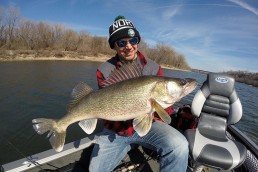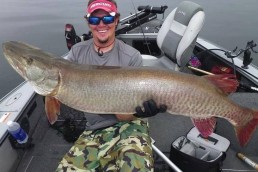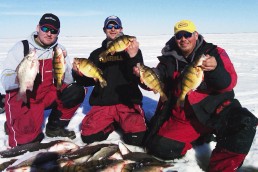A Straightforward Approach for Early-season Success on Leech Lake
SHARE THIS POST
Ahhh. The opener is finally here.
Last month, I referred to Leech Lake as a “first-round draft pick” for Minnesota lakes, which it is. And for die-hards, the walleye opener is the Super Bowl of fishing. Months are spent preparing, the excitement is building and sleepless nights are had, deciding where to start opening morning. It all culminates with that first tug on the other end of the line.
But what do we use, and where?
Prime locations to target are spawning grounds—the areas that hold baitfish and wind-driven areas. And there are tactics to employ for your search for Minnesota’s greatest fish, the walleye.
As a kid, I vividly remember sifting through a Bass Pro Shops catalog that my grandpa had given me so I could pick out a lure to order. Typically, I would look for the gaudiest, biggest lure. Bigger was better, right? While certainly a great memory, it was not a great approach, especially for the early season. I have since then scaled back my lure choices to take a more straightforward, simple approach. On Leech Lake, this means jigs.
Hands down, jigs put more fish in the boat than anything else here. However, not all jigs are created equal. There are two that stand out: the long-shank Kenkatch jigs and the VMC Moon Eye jigs. Kenkatch tackle’s long shank jig is a match made in heaven for the angler who wants a spottail shiner. With the longer shank, you can thread the hook through the mouth and out the gills, and then rehook it just on the under side below the dorsal fin of the shiner. Hooking it in this manner means the shiner will stay on for a longer period of time, especially if you are aggressively working the bait. And in the event the walleyes turn finicky, having that hook close to the tail of the bait virtually eliminates any “short bites.” Yes, it is nice when they slam the bait, but in the spring, with the shallow-water temps in flux, you will appreciate the longer shank when battling your finicky foes.
Another great jig for Leech is the VMC Moon Eye. When you look at a spottail shiner, the size of its eye stands out. With the Moon Eye jigs, it’s a kind of “match the hatch,” so to speak. I can tip it with a rainbow, fathead or even a ‘crawler. These jigs come with bait-catch on the back of the hook, which, while designed to help keep plastics on, do a great job of keeping the live bait on.
When fishing jigs, think light; go with the lightest jig you can get away with. Chuck Hasse, a guide with Leisure Outdoor Adventures, is one of the more prolific “jig fishermen” in the area. Chuck has shared that he uses mono line as light as 4-pound-test, and casting jigs as light as 1/16 ounce.
Are you enjoying this post?
You can be among the first to get the latest info on where to go, what to use and how to use it!
When asked why, Hasse simply answers, “Because it catches fish.”
And, remember, when fishing in heavier waves and wind, you will need to upsize a bit. However, again, stay as light as you can get away with.
Another straightforward, early-season tactic for Leech is the tried and true Lindy rig. I spend most openers with my dad fishing on Leech, and try as I might, I can’t get him to fish a jig. He wants to fish a Lindy rig, and when that doesn’t work, he wants a different rod—still with a Lindy rig. God bless my dad; he started me on fishing many moons ago, but he is becoming more averse to the elements as he ages. At one time, both he and I were hearty enough to endure outside hockey practices and icicles on his mustache while never getting cold. The gloves he wears now on most opening days look like the ones Neil Armstrong had on when he walked off Apollo 11.
I have adapted his set up though, unbeknownst to him. The first adjustment I make is to be sure that I give him a rod with a very soft tip. If I were to give him a rod with a stiff tip, many fish would simply drop the bait when they felt his “moon gloves” on the other end. With a medium-light rod and a fast or extra fast tip, a lot of times when he feels the bite, it is already hooked—thanks to the rod. The other adjustment I make is to shorten the snell of his Lindy rig. Three feet is the max I will go, and I will start shorter often. If you go with a longer snell, you’re allowing the bait to have more maneuverability to escape. While that darting and dodging can provoke a strike, there is a still a little lethargy in early-season fish and shortening the leash of your bait will help.
For types of equipment, again, keep it simple. For rods, stick with medium-action or medium-light action with a fast tip. For reels, there’s no need to go big here. Use something that provides good balance with your rod. For line: braided line need not apply. For me, it is tough to beat 6-pound-test mono for both jigging and rigging. I do know those who are hesitant to go that light. However, do yourself a favor and give it a shot.
The opener is indeed a glorious day. Keep your options open on Leech and go where the wind blows you. It has so many points and so much shoreline you can choose to be in the crowd, or to avoid it. When you get to that spot, keep your approach simple and straightforward and tie on a jig or a rig. There is no need for spinners or cranks—that time will come later in June and July.
Jim Ernster is a guide and pro staffer with Leisure Outdoor Adventures, a premier fishing guide service in Walker, Minn. Check them out at leisureoutdooradventures.com, or call 855-562-4665.
MWO
SHARE THIS POST
Did you enjoy this post?
You can be among the first to get the latest info on where to go, what to use and how to use it!
Jim Ernster
Jim Ernster is a guide and pro staffer with Leisure Outdoor Adventures, a premier fishing guide service in Walker, Minn. Check them out at leisureoutdooradventures.com or call 855-562-4665.




